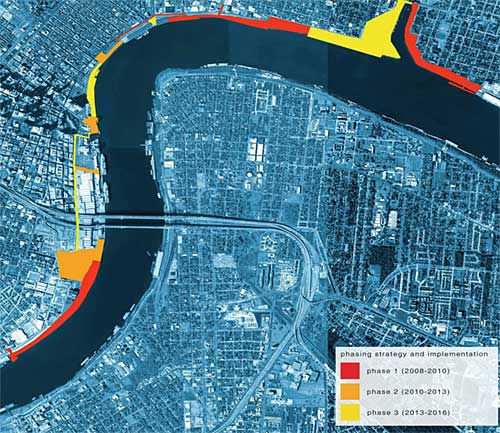A plan for redeveloping large sections of the riverfront in New Orleans took a step closer to reality when it received a green light from the city on January 9. The New Orleans Building Corporation (NOBC), whose board includes mayor Ray Nagin and three members of the City Council, endorsed conceptual plans and authorized work to begin on the project’s first phase, perhaps within months. New details about project financing were also released.
 Image courtesy New Orleans Building Corporation |
| The redevelopment of New Orleans’ riverfront encompasses several areas within a 4.5-mile along the east bank of the Mississippi River. Work could begin this year and progress, in three phases, through 2016. |
The redevelopment zone runs for 4.5 miles along the east bank of the Mississippi River, from the Lower Garden district to the Bywater neighborhood. The first of three phases, which is also the largest, will encompass $163 million of improvements in two areas. One encompasses the area between Jackson Avenue and Henderson Street, the upriver boundary of the Ernest N. Morial Convention Center, where the design calls for a park to replace deteriorated wharves as well wetland gardens and performance spaces. The second area is downriver from St. Philip and Pauline Streets, bordering the French Quarter, to Holy Cross. The plan calls for the creation of an open-air pavilion at a wharf that must remain as well as the creation of a riverfront park at Bywater Point.
The total redevelopment is projected to cost $289 million. The NOBC, which is spearheading the project, hopes to get $62 million of this amount from the city. That would include $30 million in Community Development Block Grants as well as $24 million from a deal to lease the World Trade Center, a city-owned office tower at the foot of Canal Street, expected to be signed in February; New York City-based Full Spectrum is reportedly planning to redevelop the building. NOBC also hopes to receive $45 million from the federal government and $162 million from the state. It will raise $20 million from private investors.
A report prepared by Louisiana State University economist James Richardson estimates that an investment of $289 million in public funds between now and 2016, the project’s completion date, could trigger $3.6 billion in total investment by 2024. That money would result in the creation of 5,800 construction jobs each year in addition to 24,000 permanent jobs. It could also boost tourist spending by $700 million per year.


Post a comment to this article
Report Abusive Comment